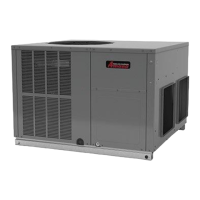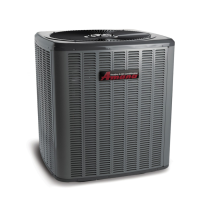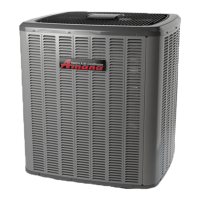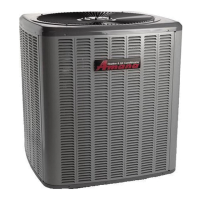10
If the outdoor ambient is low and the unit operates properly
in the heating cycle, you may check the pressure cutout
operation by blocking o the indoor return air until the unit
trips. If unit operates properly in the heating cycle, raise
the temperature setting until the heating second stage
makes contact. Supplemental resistance heat, if installed
should now come on. Make sure it operates properly.
6. THERMOSTATS WITH EMERGENCY HEAT. For
thermostats with an emergency heat switch, raise the
temperature setting until the heating second stage
makes contact. The emergency heat switch is located
at the bottom of the thermostat. Move the switch to
emergency heat. The heat pump will stop, the blower
will continue to run, all heaters will come on and the
thermostat emergency heat light will come on.
7. If checking the unit in the wintertime, when the
outdoor coil is cold enough to actuate the defrost
control, observe at least one defrost cycle to make
sure the unit defrosts completely.
1. Check to see if all supply and return air grilles are
adjusted and the air distribution system is balanced
for the best compromise between heating and cooling.
2. Check for air leaks in the ductwork.
3. Check air ow and refrigerant charge. See Sections
on and
4. Ensure the unit is free of “rattles”, and the tubing in
the unit is free from excessive vibration. Also make
sure tubes or lines are not rubbing against each other
or sheet metal surfaces or edges. If discovered,
ensure issue is corrected.
5. Set the thermostat at the appropriate setting for
cooling and heating or automatic changeover for
normal use.
6. Ensure the Owner is instructed on the unit operation,
lter, servicing, correct thermostat operation, etc.
– This control is activated (closed) by the room
thermostat for both heating and cooling. The contactor
has a 24V coil and supplies power to the compressor and
outdoor fan motor.
– This item is “ON” whenever power
is supplied to the unit and crankcase heater thermostat is
closed. Crankcase heater thermostat closes at 67° and
opens at 85°. It warms the compressor crankcase thereby
preventing liquid migration and subsequent compressor
damage. The insert type heater is self-regulating. It is
connected electrically to the contactor L1 & L2 terminals.
– This item is activated by the contactor
during heating and cooling, except during defrost and
emergency heat operation. On 460V heat pumps, the
condenser motor is activated by the CMR.
– This item is activated by the contactor for
heating and cooling, except during emergency heat. It is
protected by an internal overload.
– This control is activated by the
thermostat (24V coil) and supplies power to the contactor.
– The Defrost control provides
time/temperature initiation and termination of the defrost
cycle. When a Defrost cycle is initiated, the defrost control
shifts the reversing valve to “cooling” mode, stops the
outdoor fan and brings on supplemental heat. Normally,
a Defrost cycle will take only 2-3 minutes unless system is
low on charge or outdoor conditions are severe. (Windy
and cold). The defrost control also provides for a 3 minute
o cycle compressor delay.
– These optional controls are used
to prevent full electric heater operation at varying outdoor
ambient (0°F to 45°F). They are normally open above their
set points and closed below to permit staging of indoor
supplement heater operation. If the outdoor ambient
temperature is below 0°F (-18°C) with 50% or higher RH,
an outdoor thermostat (OT) must be installed and set at
(0°F) on the dial. Failure to comply with this requirement
may result in damage to the product which may not be
covered by the manufacturer’s warranty.
– This
outdoor thermostat is an optional accessory that is pre-set
from the factory at 37°F. No other eld setting is required.
It comes enclosed in a “birdhouse” and should be mounted
on the corner panel near the control panel. Once the
ambient temperature falls below the set temperature of
37°F during heating operation, the thermostat closes and
forces the two-stage compressor to run in high stage.
– This coil is activated by the
thermostat, in the colling mode and during defrost. It
positions the reversing valve pilot valve for cooling
operation.
– Units with ECM Motors. The
ECM model indoor blower motor is activated by the room
thermostat by cooling/heating or fan “ON” position. ECM
motors are constant airow motors with the very low power
consumption. (See Air Flow Measurement and Adjustment
for speed adjustment instructions).
– This relay is used to energize
the blower during the electric heat operation. Some room
thermostats do not energize the motor during electric
heat. This relay ensures blower operation when the room
thermostat energizes heat. This relay is energized by the
electric heat kit sequencer.

